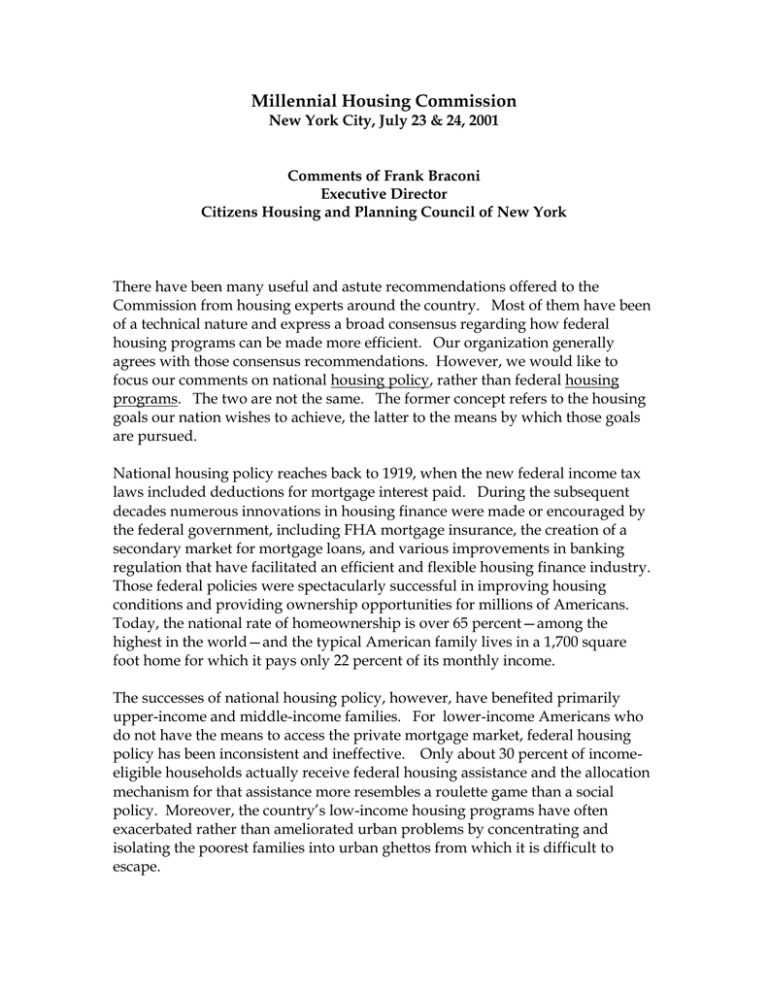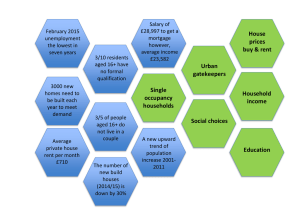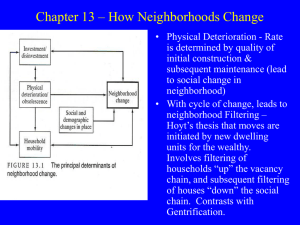Millennial Housing Commission
advertisement

Millennial Housing Commission New York City, July 23 & 24, 2001 Comments of Frank Braconi Executive Director Citizens Housing and Planning Council of New York There have been many useful and astute recommendations offered to the Commission from housing experts around the country. Most of them have been of a technical nature and express a broad consensus regarding how federal housing programs can be made more efficient. Our organization generally agrees with those consensus recommendations. However, we would like to focus our comments on national housing policy, rather than federal housing programs. The two are not the same. The former concept refers to the housing goals our nation wishes to achieve, the latter to the means by which those goals are pursued. National housing policy reaches back to 1919, when the new federal income tax laws included deductions for mortgage interest paid. During the subsequent decades numerous innovations in housing finance were made or encouraged by the federal government, including FHA mortgage insurance, the creation of a secondary market for mortgage loans, and various improvements in banking regulation that have facilitated an efficient and flexible housing finance industry. Those federal policies were spectacularly successful in improving housing conditions and providing ownership opportunities for millions of Americans. Today, the national rate of homeownership is over 65 percent—among the highest in the world—and the typical American family lives in a 1,700 square foot home for which it pays only 22 percent of its monthly income. The successes of national housing policy, however, have benefited primarily upper-income and middle-income families. For lower-income Americans who do not have the means to access the private mortgage market, federal housing policy has been inconsistent and ineffective. Only about 30 percent of incomeeligible households actually receive federal housing assistance and the allocation mechanism for that assistance more resembles a roulette game than a social policy. Moreover, the country’s low-income housing programs have often exacerbated rather than ameliorated urban problems by concentrating and isolating the poorest families into urban ghettos from which it is difficult to escape. Citizens Housing and Planning Council of New York The most effective and equitable housing policy would be one that provides housing security for all eligible Americans through Section 8 rent supplements. Rent supplements provide tenants the greatest amount of choice and mobility, maximize the role of the private housing sector, and can be combined with federal, state or local capital grants to provide the greatest flexibility for financing new housing development. Unfortunately, implementation of a fullyfunded rent subsidy program seems more remote now than it did when the Nixon administration first proposed it. It strikes us that in lieu of a fully-funded rent subsidy program, federal housing assistance should be targeted in a manner which maximizes the benefits to lowincome families and the localities they live in. Strategic targeting of housing assistance requires, however, a much deeper and complete understanding of the effects of housing and neighborhood conditions than we currently have. The existing research on housing issues is still quite primitive compared to that on other areas of social policy. We hope that the Commission will recommend greater federal support for efforts to understand the relationship of housing conditions to other social problems and federal efforts to address them. During the past several years our organization has endeavored to better understand the effects of poor or unstable housing conditions on the life prospects of urban families. One of our recent projects, the results of which are forthcoming in the Fannie Mae Foundation’s Housing Policy Debate, explored the relationship between substandard housing conditions and adults’ health and employment stability. We found that a woman’s risk of being out of the labor force due to ill health or disability is increased by 60 percent if she lives in substandard housing. Since nearly 20 percent of New York City’s renters live in housing that is substandard by our criteria, the findings imply that poor housing conditions may have a substantial effect on public health and significantly contribute to joblessness and high public and private health care costs. Another recent study our organization conducted explored the effects of various housing circumstances on the educational attainment of children in New York. In several areas we confirmed the findings of previous researchers: that parents’ homeownership appears to significantly increase the chances that their children will complete high school, and that housing instability and excessive mobility are extremely adverse to children’s educational achievement. We also obtained several new findings which indicate that residence in overcrowded housing or in maintenance-deficient housing also has adverse effects on children’s educational attainment. We believe such research has important implications for the role of housing policy in achieving broader public objectives and for how housing policy can be refined to have the most beneficial impacts. Citizens Housing and Planning Council of New York We believe that much more research is needed into these and other areas. In particular, we need to have a better understanding of the pathways through which substandard and unstable housing conditions effect the health and productivity of parents and their children. We also need to gain a better understanding of how neighborhood conditions affect individual behavior and life outcomes. For example, one area that remains entirely unexplored is the connection between housing and community development and public safety. There is ample anecdotal and circumstantial evidence that deteriorated physical conditions and high poverty concentrations contribute to the high levels of crime and violence in urban areas; a more careful coordination of urban redevelopment and policing strategies could have immense benefits for urban communities. The research cited earlier points to specific ways national housing programs can be retargeted to accomplish tangible policy goals. For example, localities should be given broader flexibility to utilize Section 8 vouchers to compliment rehabilitation programs, which may be funded with Community Development Block Grant monies, in order to upgrade deteriorated private housing. Such flexibility could help to alleviate the worst-case conditions in the private rental housing in which most poor people live, contributing to improvements in health and, by ensuring that it remains affordable to low-income tenants, reducing the excessive housing mobility that immensely complicates the problems of innercity schools. Federal policy can also be rationalized so that it is more consistent with our current understanding of how neighborhood conditions influence children’s life prospects. For instance, the income limits on Low Income Housing Tax Credit projects should be liberalized so that they do not encourage the excessive concentration of very poor families into particular buildings and particular neighborhoods. That would help to revitalize communities and also insulate the Tax Credit program from a preservation crisis some years down the road. In summary, CHPC believes that federal housing policy has suffered because its goals have become too diffused and contradictory. If policy were better informed by contemporary research findings and retargeted to achieve maximum benefits to needy populations, federal housing programs could become much more effective tools for solving social problems.



